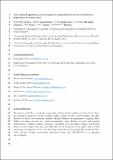Files in this item
Uses, cultural significance, and management of peatlands in the Peruvian Amazon : implications for conservation
Item metadata
| dc.contributor.author | Schulz, Christopher | |
| dc.contributor.author | Martín Brañas, Manuel | |
| dc.contributor.author | Núñez Pérez, Cecilia | |
| dc.contributor.author | Del Aguila Villacorta, Margarita | |
| dc.contributor.author | Laurie, Nina | |
| dc.contributor.author | Lawson, Ian T. | |
| dc.contributor.author | Roucoux, Katherine H. | |
| dc.date.accessioned | 2020-05-19T23:34:11Z | |
| dc.date.available | 2020-05-19T23:34:11Z | |
| dc.date.issued | 2019-07 | |
| dc.identifier | 259034365 | |
| dc.identifier | 56ca4dc8-115b-442c-a852-eeabb6581c86 | |
| dc.identifier | 85065044308 | |
| dc.identifier | 000472696400020 | |
| dc.identifier.citation | Schulz , C , Martín Brañas , M , Núñez Pérez , C , Del Aguila Villacorta , M , Laurie , N , Lawson , I T & Roucoux , K H 2019 , ' Uses, cultural significance, and management of peatlands in the Peruvian Amazon : implications for conservation ' , Biological Conservation , vol. 235 , pp. 189-198 . https://doi.org/10.1016/j.biocon.2019.04.005 | en |
| dc.identifier.issn | 0006-3207 | |
| dc.identifier.other | RIS: urn:099152B32B72A8C4512CADC83E464109 | |
| dc.identifier.other | ORCID: /0000-0003-0081-1404/work/64361362 | |
| dc.identifier.other | ORCID: /0000-0001-6757-7267/work/64698089 | |
| dc.identifier.other | ORCID: /0000-0002-3547-2425/work/75996945 | |
| dc.identifier.uri | https://hdl.handle.net/10023/19965 | |
| dc.description | Funding from the Scottish Funding Council (Global Challenges Research Fund 2017–2018) and the Natural Environment Research Council (ref. NE/R000751/1) is gratefully acknowledged. | en |
| dc.description.abstract | Tropical peatlands play an important role in the global carbon cycle by acting as significant carbon stores. South America's largest peatland complex is located in the Loreto Region of the Peruvian Amazon. Here we present the first study of human relations with these peatlands, including their uses, cultural significance and current management, as well as implications for conservation, based on qualitative research with people living in two riverine rural communities. Our results indicate that peatlands are culturally ambiguous spaces, used mainly for hunting, palm fruit harvesting, and timber, but feared due to the dangers of getting lost, sinking into the ‘sucking’ ground, and being attacked by anacondas and/or mythical creatures. While the difficult terrain and remoteness of peatlands have thus far acted as natural barriers to their destruction through conversion to different land uses, overuse of natural resources is nevertheless a significant concern for people living in the peat-dominated landscape of the Peruvian Amazon, mixed with frustration about the lack of outside support to foster environmental conservation and economic opportunities. We explore how evaluations of the present situation differ across one indigenous and one mestizo community. We identify a range of nascent peatland conservation strategies, including seedling planting to regrow valuable (palm) trees, and the climbing of palm trees for harvesting fruit as opposed to felling them. We argue that peatland conservation could be combined with the development of sustainable management strategies, but that this would require sustained engagement by outside organisations with rapidly growing local communities in these areas. | |
| dc.format.extent | 10 | |
| dc.format.extent | 696049 | |
| dc.language.iso | eng | |
| dc.relation.ispartof | Biological Conservation | en |
| dc.subject | Amazon | en |
| dc.subject | Conservation | en |
| dc.subject | Environmental management | en |
| dc.subject | Peatlands | en |
| dc.subject | Peru | en |
| dc.subject | Urarina | en |
| dc.subject | G Geography (General) | en |
| dc.subject | E-NDAS | en |
| dc.subject | SDG 15 - Life on Land | en |
| dc.subject.lcc | G1 | en |
| dc.title | Uses, cultural significance, and management of peatlands in the Peruvian Amazon : implications for conservation | en |
| dc.type | Journal article | en |
| dc.contributor.sponsor | NERC | en |
| dc.contributor.institution | University of St Andrews. School of Geography & Sustainable Development | en |
| dc.contributor.institution | University of St Andrews. Centre for Research into Equality, Diversity & Inclusion | en |
| dc.contributor.institution | University of St Andrews. Bell-Edwards Geographic Data Institute | en |
| dc.identifier.doi | 10.1016/j.biocon.2019.04.005 | |
| dc.description.status | Peer reviewed | en |
| dc.date.embargoedUntil | 2020-05-20 | |
| dc.identifier.grantnumber | NE/R000751/1 | en |
This item appears in the following Collection(s)
Items in the St Andrews Research Repository are protected by copyright, with all rights reserved, unless otherwise indicated.

